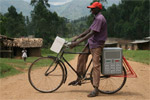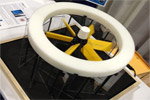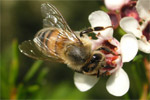Medicine |
|
Medicina |
Is this the first cure for HIV?

|
|
Je li ovo prvi lijek za HIV?

|
Technology |
|
Tehnologija |
China has faster and more secure internet

|
|
Kina ima brži i sigurniji internet

|
A novel way to charge cellphones

|
|
Novi način za punjenje mobilnih telefona

|
A new type of tank for natural-gas cars

|
|
Nova vrsta spremnika za automobile na prirodni plin

|
Ecology |
|
Ekologija |
Fiery ice is Japan's fuel of the future

|
|
Vatreni led je japansko gorivo budućnosti

|
Artificial whirlwinds

|
|
Umjetni zračni vrtlozi

|
Nature |
|
Priroda |
Electric plant auras guide bees

|
|
Električne aure biljaka vode pčele

|
Cuisine |
|
Kulinarstvo |
Mexican chicken stew with quinoa and beans

|
|
Meksički pileći paprikaš s quinoom i grahom

|
|
|
|
|

Is this the first cure for HIV?
For the first time, a person with HIV (a baby aged 2) has reportedly been "cured" of the infection through treatment with antiretroviral drugs (ARVs).
Although the claim raises the possibility of eliminating HIV infection in millions of babies, questions have been raised as to whether the so-called cure is permanent.
Pregnant women with HIV usually receive ARVs that reduce the risk of transmission to their baby from 5 to 40 per cent.
If this is not possible, the baby will usually be given one ARV.
If infection is confirmed, the baby may then be put on three ARVs.
In this case, the mother's HIV infection was discovered too late in pregnancy for ARVs to be effective.
Rather than wait for confirmation that the baby was infected, doctors at the University of Mississippi Medical Centre in Jackson decided to give the baby three standard ARVs straight away.
They continued the treatment for 18 months, during which time the baby was confirmed to be positive for HIV.
Then the doctors lost contact with mother and child.
When they reappeared, doctors were astonished to find that the girl had no active, replicating traces of the virus, even though she was no longer taking her medication...
 Search for more... Search for more... 
For the first time, a person with HIV (a baby aged 2) has reportedly been "cured" of the infection through treatment with antiretroviral drugs (ARVs).
Although the claim raises the possibility of eliminating HIV infection in millions of babies, questions have been raised as to whether the so-called cure is permanent.
Pregnant women with HIV usually receive ARVs that reduce the risk of transmission to their baby from 5 to 40 per cent.
If this is not possible, the baby will usually be given one ARV.
If infection is confirmed, the baby may then be put on three ARVs.
In this case, the mother's HIV infection was discovered too late in pregnancy for ARVs to be effective.
Rather than wait for confirmation that the baby was infected, doctors at the University of Mississippi Medical Centre in Jackson decided to give the baby three standard ARVs straight away.
They continued the treatment for 18 months, during which time the baby was confirmed to be positive for HIV.
Then the doctors lost contact with mother and child.
When they reappeared, doctors were astonished to find that the girl had no active, replicating traces of the virus, even though she was no longer taking her medication.
People with HIV must take ARVs for life because the virus hides away in the body, particularly in CD4 white blood cells, and re-emerges if they stop medication.
For 10 months the girl was off treatment, yet there was no trace of the virus.
However, some researchers are cautious.
"At present, this can best be described as a functional rather than sterilising cure", says Mario Stevenson of the University of Miami, Florida.
But he also says that all babies of HIV-infected mothers should receive three ARVs from now on.
Following revised guidelines from the World Health Organization, several countries in Africa are now giving ARVs to all mothers who are HIV-positive, rather than only those whose CD4 cell count has fallen below 350 per millilitre of blood as a result of the infection.
Evidence is being gathered on whether this reduces the rate of infection in unborn babies.
If giving three ARVs shows potential in further studies, it could help millions.
In sub-Saharan Africa alone, an estimated 300,000 infants acquired HIV infection from their mother in 2011.
"This news gives us great hope that a cure for HIV in children is possible and could bring us one step closer to an AIDS-free generation", said UNAIDS executive director Michel Sidibe.
» Search for more... 
|
|

Je li ovo prvi lijek za HIV?
Po prvi je put osoba s HIV-om (beba stara 2 godine) navodno "izliječena" od zaraze tako što je liječena antiretrovirusnim lijekovima (ARV-ovima).
Iako ova tvrdnja povećava mogućnost uklanjanja zaraze HIV-om kod milijuna djece, postavljaju se pitanja je li takozvani lijek trajan.
Trudnice s HIV-om obično dobivaju ARV-ove koji smanjuju rizik od prijenosa na njihovo dijete za 5 do 40 posto.
Ako to nije moguće, jedan ARV se obično daje djetetu.
Ako je infekcija potvrđena, djetetu je tada moguće dati tri ARV-a.
U ovom je slučaju majčina infekcija HIV-om otkrivena prekasno u trudnoći da bi ARV-ovi bili učinkoviti.
Umjesto da čekaju potvrdu da je dijete zaraženo, liječnici s Medicinskog centra na Sveučilištu u Mississippiju u Jacksonu odlučili su odmah dati djetetu tri standardna ARV-a.
Oni su nastavili liječenje još 18 mjeseci, a za to je vrijeme ustanovljeno da je dijete pozitivno na HIV.
Tada su liječnici izgubili kontakt s majkom i djetetom.
Kada su se oni ponovno pojavili, liječnici su bili zapanjeni kada su otkrili da kod djevojčice ne postoje tragovi aktivnih virusa koji se repliciraju, iako više nije uzimala lijekove...
 Potraži više... Potraži više... 
Po prvi je put osoba s HIV-om (beba stara 2 godine) navodno "izliječena" od zaraze tako što je liječena antiretrovirusnim lijekovima (ARV-ovima).
Iako ova tvrdnja povećava mogućnost uklanjanja zaraze HIV-om kod milijuna djece, postavljaju se pitanja je li takozvani lijek trajan.
Trudnice s HIV-om obično dobivaju ARV-ove koji smanjuju rizik od prijenosa na njihovo dijete za 5 do 40 posto.
Ako to nije moguće, jedan ARV se obično daje djetetu.
Ako je infekcija potvrđena, djetetu je tada moguće dati tri ARV-a.
U ovom je slučaju majčina infekcija HIV-om otkrivena prekasno u trudnoći da bi ARV-ovi bili učinkoviti.
Umjesto da čekaju potvrdu da je dijete zaraženo, liječnici s Medicinskog centra na Sveučilištu u Mississippiju u Jacksonu odlučili su odmah dati djetetu tri standardna ARV-a.
Oni su nastavili liječenje još 18 mjeseci, a za to je vrijeme ustanovljeno da je dijete pozitivno na HIV.
Tada su liječnici izgubili kontakt s majkom i djetetom.
Kada su se oni ponovno pojavili, liječnici su bili zapanjeni kada su otkrili da kod djevojčice ne postoje tragovi aktivnih virusa koji se repliciraju, iako više nije uzimala lijekove.
Osobe s HIV-om moraju cijeli život uzimati ARV-ove, jer se virus skriva u tijelu, naročito u bijelim krvnim stanicama CD4, a ponovno se pojavljuje ako se prestane s uzimanjem lijekova.
Djevojčica je bila bez lijekova 10 mjeseci, ali nije pronađen ni trag virusa.
Međutim, neki su znanstvenici oprezni.
"U ovom se trenutku ovaj lijek najbolje može opisati kao funkcionalan, a ne sterilizirajući", kaže Mario Stevenson sa Sveučilišta u Miamiju na Floridi.
Međutim, kaže i da bi sva djeca majki zaraženih HIV-om od sada pa nadalje trebala dobivati tri ARV-a.
Prateći revidirane smjernice Svjetske zdravstvene organizacije, nekoliko zemalja u Africi sada daje ARV-ove svim majkama koje su pozitivne na HIV, a ne samo onima čiji je broj CD4 stanica pao ispod 350 po mililitru krvi kao posljedica infekcije.
Prikupljaju se dokazi smanjuje li to stopu infekcije kod nerođene djece.
Ako davanje tri ARV-a pokaže potencijal za daljnja istraživanja, to bi moglo pomoći milijunima.
Procjenjuje se da je samo u subsaharskoj Africi 300.000 djece dobilo infekciju HIV-om od svojih majki tijekom 2011. godine.
"Ova nam vijest daje veliku nadu da je lijek za HIV kod djece moguć i da bi nas mogao za još jedan korak mogao približiti generaciji bez AIDS-a", izjavio je Michel Sidibe, izvršni direktor UNAIDS-a.
» Potraži više... 
|
|
|
|
|

China has faster and more secure internet
The internet is getting old: it is rapidly running out of space and remains fundamentally insecure.
And it seems that China is leading the way in doing something about it.
At the root of the problem are two major gaps in the architecture of the internet.
First up is the internet's inability to block malicious traffic as a whole.
While malware can rapidly replicate and distribute itself across the net, organisations can only respond to individual instances of online aggression.
China is already using better defences.
The most important aspect of its next-generation network backbone is a security feature known as "Source Address Validation Architecture" (SAVA).
Many of the existing security problems stem from an inability to authenticate IP addresses of computers that try to connect to your network.
 Search for more... Search for more... 
|
|

Kina ima brži i sigurniji internet
Internet postaje star: brzo mu ponestaje prostora, a u osnovi je i dalje nesiguran.
A čini se da Kina vodi u nastojanjima da nešto poduzme po tom pitanju.
U korijenu problema nalaze se dva glavna nedostatka u arhitekturi interneta.
Prvi je nemogućnost interneta da blokira zlonamjerni promet u cjelini.
Dok se zloćudni softver može brzo replicirati i sam sebe distribuirati preko mreže, organizacije mogu odgovoriti samo na pojedinačne slučajeve internetske agresije.
Kina već koristi bolju obranu.
Najvažniji aspekt njihove mrežne okosnice sljedeće generacije predstavlja sigurnosna značajka pod nazivom "arhitektura za potvrđivanje izvornih adresa" (SAVA - Source Address Validation Architecture).
Mnogi od postojećih sigurnosnih problema proizlaze iz nemogućnosti da se ustanovi autentičnost IP adresa onih računala koja se pokušavaju spojiti na vašu mrežu.
 Potraži više... Potraži više... 
|

A novel way to charge cellphones
On the edge of Uganda's Mount Elgon national park, Juliet Nandutu is trying out a new toy: a solar-powered cellphone charging station that is activated by text message.
She is offering the service to her village.
"I charge 18 phones a day, sometimes 20", she says.
How many phones she charges depends on the local electricity supply.
When it's there, people can charge their phones at home, but that's not very often.
"Electricity supply is not very reliable here", she says.
A patchy electricity supply poses a big problem for rural areas in the developing countries, particularly in Africa and Asia, where the use of cellphones is rapidly rising.
Farmers, for instance, use cellphones to get up-to-date pricing information for local and distant markets, allowing them to better manage the sales of their crops.
In Kenya, people without access to banking services exchange money using their phones.
Still, an estimated 500 to 650 million cellphone users are off-grid.
 Search for more... Search for more... 
|
|

Novi način za punjenje mobilnih telefona
Na rubu nacionalnog parka Mount Elgon u Ugandi, Juliet Nandutu isprobava novu igračku: postaju za punjenje mobilnih telefona koja radi na solarnu energiju i koja se aktivira putem SMS poruke.
Ona nudi uslugu svom selu.
"Punim 18 telefona dnevno, ponekad 20", kaže ona.
Broj telefona koje puni ovisi o lokalnoj opskrbi električnom energijom.
Kada je ima, ljudi mogu napuniti svoje telefone kod kuće, ali to nije jako često.
"Opskrba električnom energijom ovdje nije vrlo pouzdana", kaže ona.
Isprekidana opskrba električnom energijom predstavlja velik problem za ruralna područja zemalja u razvoju, posebno u Africi i Aziji, gdje uporaba mobilnih telefona ubrzano raste.
Poljoprivrednici, na primjer, koriste mobilne telefone kako bi dobili najnovije informacije o cijenama za lokalna i udaljena tržišta, što im omogućuje da bolje upravljaju prodajom svojih usjeva.
U Keniji, ljudi bez pristupa bankarskim uslugama razmjenjuju novac koristeći svoje telefone.
Pa ipak, procjenjuje se da je oko 500 do 650 milijuna korisnika mobilnih telefona izvan mreže.
 Potraži više... Potraži više... 
|

A new type of tank for natural-gas cars
A fuel tank inspired by the human gut could make cars running on natural gas more attractive to motorists.
Emissions from engines fuelled by compressed natural gas are 10 per cent lower than those from a petrol engine.
However, because methane's energy density is lower, about 30 per cent more fuel is needed to maintain a vehicle's range.
That requires fatter, heavier, high-pressure fuel tanks, which eat up space, increase fuel consumption and increase the price of the car...
 Search for more... Search for more... 
|
|

Nova vrsta spremnika za automobile na prirodni plin
Spremnik za gorivo koji je inspiriran ljudskim crijevima mogao bi učiniti automobile na prirodni plin privlačnijima za vozače.
Emisije iz motora koji kao pogonsko gorivo koriste komprimirani prirodni plin su 10 posto niže od onih iz benzinskog motora.
Međutim, budući da je energetska gustoća metana manja, potrebno je oko 30 posto više goriva kako bi se zadržao doseg vozila.
To zahtijeva deblje i teže spremnike goriva pod visokim tlakom, koji gutaju prostor, povećavaju potrošnju goriva i povećavaju cijenu automobila...
 Potraži više... Potraži više... 
|
|
|
|
|

Fiery ice is Japan's fuel of the future
In the search for new sources of energy, Japan is digging deep.
Just off its south-west coast, 1300 metres below the surface, a huge cache of slushy, combustible ice lies buried in the ocean floor.
This month, Japan is carrying out the first offshore attempt to produce methane gas from these frozen methane hydrates.
If this becomes successful, this could be the next great energy source.
Methane hydrates consist of methane molecules trapped in a structure of water called a clathrate.
Cold temperatures and high pressures keep them solid, and their compressed structure gives them 164 times the energy potential of an equivalent volume of natural gas.
They are abundant in ocean floors around the world and under Arctic permafrost.
Some estimate that our planet holds three times more gas in hydrates than in traditional gas, and that their total energy is greater than all other energy sources combined.
The US, India, South Korea and Russia all have programmes to explore the potential of hydrates, but the on-going natural gas boom makes them a low priority for now.
Japan is the exception.
It has invested hundreds of millions of dollars in hydrate research.
 Search for more... Search for more... 
|
|

Vatreni led je japansko gorivo budućnosti
Japan kopa duboko u potrazi za novim izvorima energije.
Odmah pokraj njegove jugozapadne obale, 1300 metara ispod površine, velika zaliha bljuzgavog i zapaljivog leda leži zakopana u oceanskom dnu.
Ovog mjeseca Japan provodi prvi pokušaj pučinske proizvodnje metana od tih zamrznutih metanovih hidrata.
Ako to postane uspješno, moglo bi biti sljedeći veliki izvor energije.
Metanovi hidrati sastoje se od molekula metana zarobljenih u strukturi vode pod nazivom klatrat.
Niske temperature i visoki pritisci održavaju ih čvrstima, a njihova komprimirana struktura daje im 164 puta veći energetski potencijal od ekvivalentnog obujma prirodnog plina.
Ima ih u izobilju u oceanskom dnu diljem svijeta i pod arktičkim vječnim ledom.
Neki procjenjuju da naš planet sadrži tri puta više plina u hidratima nego u tradicionalnom plinu, a da je njegova ukupna energija veća od svih ostalih izvora energije zajedno.
SAD, Indija, Južna Koreja i Rusija sve imaju programe za istraživanje potencijala hidrata, ali ih tekuća ekspanzija prirodnog plina zasad čini programima s niskim prioritetom.
Japan je iznimka.
Uložio je stotine milijuna dolara u istraživanje hidrata.
 Potraži više... Potraži više... 
|

Artificial whirlwinds
Whirlwinds are usually associated with destruction, not sustainable energy.
Now it seems we can harness their power to generate renewable electricity.
The Solar Vortex system is the brainchild of Mark Simpson and Ari Glezer at Georgia Institute of Technology in Atlanta.
It relies on the temperature difference between hot air close to the ground and cooler air just a metre above it.
As the hot air rises and cool air falls, convection currents form between these layers, creating small whirlwinds.
Solar Vortex channels these currents with an array of fixed vanes.
They turn the airflow into a vortex, which turns a turbine at the device's centre.
No power is needed to kick the process off as the position of the vanes helps the vortex to appear spontaneously.
Maintenance and installation costs are much lower than for a conventional wind farm because there is no need to put turbines on high towers to catch the wind...
 Search for more... Search for more... 
|
|

Umjetni zračni vrtlozi
Zračni vrtlozi se obično povezuju s uništenjem, a ne održivom energijom.
Sada se čini da možemo iskoristiti njihovu moć kako bismo proizvodili obnovljivu električnu energiju.
Sustav po nazivu Solar Vortex osmislili su Mark Simpson i Ari Glezer sa Tehnološkog instituta u Georgiji u Atlanti.
Sustav se oslanja na temperaturne razlike između toplog zraka blizu tla i hladnijeg zraka samo metar iznad njega.
Dok se vrući zrak diže a hladan zrak pada, između tih se slojeva stvaraju konvekcijske struje koje stvaraju male zračne vrtloge.
Sustav Solar Vortex usmjerava te struje uz pomoć niza pričvršćenih lopatica.
One pretvaraju protok zraka u vrtlog koji okreće turbinu u centru uređaja.
Za pokretanje procesa nije potrebno napajanje, jer položaj lopatica pomaže da se vrtlog stvori spontano.
Troškovi održavanja i ugradnje su mnogo niži nego kod konvencionalnih vjetroelektrana, budući da nema potrebe da se turbine postavljaju na visoke tornjeve kako bi uhvatile vjetar...
 Potraži više... Potraži više... 
|
|
|
|
|

Electric plant auras guide bees
Daniel Robert at the University of Bristol, UK, and colleagues made a few artificial flowers.
These looked and smelled identical but some were filled with sucrose and others with quinine, a substance bees don't feed on.
At first, the bees visited these flowers at random.
But when a static electric field (typical for a flower) was applied to the blooms filled with sucrose, the team found that the bees could detect the field from a few centimetres away and visited such flowers 81 per cent of the time.
The bees reverted to random behaviour when the field was switched off.
The result suggests the bees used the electric field as an indicator of the presence of food, much like they use colour and scent.
In the absence of a charge, they foraged at random, showing that they hadn't just learned the location of the sucrose flowers.
"That was the first hint that had us jumping up and down", says Robert.
Next, the team looked at whether the bees were influenced by the shape of an electric field, which is determined by a flower's shape...
 Search for more... Search for more... 
|
|

Električne aure biljaka vode pčele
Daniel Robert sa Sveučilišta u Bristolu u Ujedinjenom Kraljevstvu i njegovi kolege napravili su nekoliko umjetnih cvjetova.
Oni su izgledali i mirisali identično, ali su neki od njih bili napunjeni saharozom a drugi kininom, tvari kojom se pčele ne hrane.
Isprva su pčele nasumce posjećivale to cvijeće.
No, kada je statično električno polje (tipično za cvijet) primijenjeno na cvjetove napunjene saharozom, tim je otkrio da pčele mogu detektirati polje sa udaljenosti od nekoliko centimetara te da posjećuju takve cvjetove 81 posto vremena.
Pčele su se vratile nasumičnom ponašanju kada je polje bilo isključeno.
Rezultat sugerira da su pčele koristile električno polje kao pokazatelj prisutnosti hrane, baš kao što koriste boju i miris.
U nedostatku električnog naboja, tražile su hranu nasumce, pokazujući da nisu jednostavno naučile lokaciju cvijeća sa saharozom.
"To je bio prvi nagovještaj od kojeg smo skakali od sreće", kaže Robert.
Zatim je tim gledao utječe li na pčele oblik električnog polja, koji je određen oblikom cvijeta...
 Potraži više... Potraži više... 
|
|
|
|
|

Mexican chicken stew with quinoa and beans
Spicy stew with protein-rich quinoa.
Serves 4.
Ingredients
1 tbsp olive oil
1 onion, sliced
2 red peppers, deseeded and chopped into largish chunks
3 tbsp chipotle paste
800g chopped tomatoes
4 skinless chicken breasts
140g quinoa
2 chicken stock cubes
400g pinto beans, drained
small bunch of coriander, mostly chopped, with a few leaves left whole
juice of 1 lime
1 tbsp sugar
natural yogurt
Method
Heat the oil in a deep frying pan and fry the onions and peppers for a few minutes until softened.
Stir in the chipotle paste followed by the tomatoes...
 Search for more... Search for more... 
|
|

Meksički pileći paprikaš s quinoom i grahom
Pikantni paprikaš sa quinoom bogatom proteinima.
Za 4 osobe.
Sastojci
1 žlica maslinovog ulja
1 luk, narezan
2 crvene paprike, očišćene i nasjeckane na veće komade
3 žlice umaka od chipotle paprika
800g sjeckanih rajčica
4 pileća prsa bez kože
140g quinoe
2 pileće kocke za temeljac
400g pinto graha, ocijeđenog
mali svežanj korijandera, većinom sjeckanog, s nekoliko cijelih listova
sok jedne limete
1 žlica šećera
prirodni jogurt
Način pripreme
Zagrijte ulje u dubokoj tavi za pečenje i pržite luk i paprike nekoliko minuta dok ne omekšaju.
Umiješajte umak od chipotle paprika i nakon toga rajčice...
 Potraži više... Potraži više... 
|
|
|
